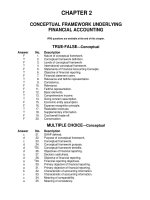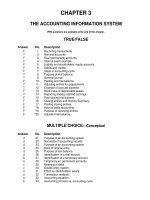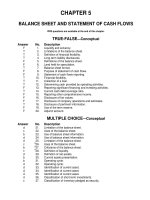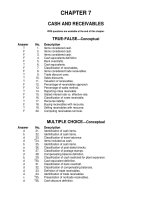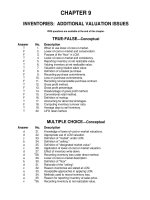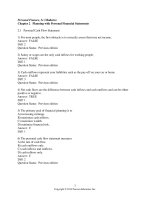Solution and test bank personal finance 6th by jeff madura 2017 chapter 3
Bạn đang xem bản rút gọn của tài liệu. Xem và tải ngay bản đầy đủ của tài liệu tại đây (416.66 KB, 27 trang )
Personal Finance, 6e (Madura)
Chapter 3 Applying Time Value Concepts
3.1 The Importance of the Time Value of Money
1) The time period over which you save money has very little impact on its growth.
Answer: FALSE
Diff: 1
Question Status: Previous edition
2) The time value of money concept can help you determine how much money you need to save
over a period of time to achieve a specific savings goal.
Answer: TRUE
Diff: 1
Question Status: Previous edition
3) Time value of money calculations, such as present and future value amounts, can be applied to
many day-to-day decisions.
Answer: TRUE
Diff: 1
Question Status: Revised
4) Time value of money is only applied to single dollar amounts.
Answer: FALSE
Diff: 1
Question Status: Previous edition
5) Your utility bill, which varies each month, is an example of an annuity.
Answer: FALSE
Diff: 1
Question Status: Previous edition
6) In general, a dollar can typically buy more today than it can in one year.
Answer: TRUE
Diff: 1
Question Status: Revised
7) An annuity is a stream of equal payments that are received or paid at equal intervals in time.
Answer: TRUE
Diff: 1
Question Status: Previous edition
8) An annuity is a stream of equal payments that are received or paid at random periods of time.
Answer: FALSE
Diff: 2
Question Status: Previous edition
1
Copyright © 2017 Pearson Education, Inc.
9) Time value of money computations relate to the future value of lump-sum cash flows only.
Answer: FALSE
Diff: 2
Question Status: Revised
10) There are two sets of present and future value tables: one set for lump sums and one set for
annuities.
Answer: TRUE
Diff: 1
Question Status: Previous edition
11) Money received today is worth more than the same amount of money received in the future.
This is true because
A) money received today can grow at a compounded rate.
B) future inflation will devalue your current investments.
C) all goods and services will cost more in the future.
D) unique investment opportunities exist today, which may not be available in the future.
Answer: A
Diff: 2
Question Status: Revised
12) The time value of money refers to
A) personal opportunity costs such as time lost on an activity.
B) financial decisions that require borrowing funds from a bank.
C) changes in interest rates due to changes in the supply and demand for money in the national
economy.
D) the difference in the value of money depending on when it is received.
Answer: D
Diff: 2
Question Status: Revised
13) The time value of money implies that a dollar received today is worth ________ a dollar
received tomorrow.
A) more than
B) less than
C) the same as
D) Insufficient data to determine the answer.
Answer: A
Diff: 1
Question Status: Revised
2
Copyright © 2017 Pearson Education, Inc.
14) The concept of the time value of money is based on
A) the level of unemployment.
B) taxes.
C) interest earned over time
D) the Dow Jones Industrial Average.
Answer: C
Diff: 1
Question Status: Revised
15) An ordinary annuity can be defined as
A) a series of unequal payments received or paid at equal intervals at the beginning of each
period.
B) a series of equal payments received or paid at equal intervals of time at the end of each
period.
C) a lump sum.
D) intermittent payments for ordinary expenses.
Answer: B
Diff: 2
Question Status: Revised
16) Which of the following it not an annuity?
A) Equal monthly payments to your investment account
B) Lottery winnings of $100 per month for life
C) Mortgage payments for a fixed-rate loan
D) Monthly utility bills
Answer: D
Diff: 2
Question Status: Revised
17) The concept of time value of money is important to financial decision making because
A) it emphasizes earning a return of interest on the money you invested.
B) it recognizes that $1 today has more value than $1 received a year from now.
C) it can be applied to future cash flows in order to compare different streams of income.
D) all of these.
Answer: D
Diff: 2
Question Status: Previous edition
18) The concept that a dollar received today has more value than a dollar received in the future
because of the interest it can earn is called the ________.
Answer: time value of money
Diff: 1
Question Status: Previous edition
3
Copyright © 2017 Pearson Education, Inc.
19) A stream of equal payments either received or paid at equal time intervals is a(n) ________.
Answer: annuity
Diff: 1
Question Status: Previous edition
20) Which stream of cash flows is not an example of an annuity?
A) Fixed rate mortgage payment
B) Mortgage payment where the interest rate is reset annually
C) 48 month car payment
D) Interest payment on a 10 year Treasury bond
Answer: B
Diff: 1
Question Status: New
21) Time value of money is important because
A) you do not want to wait a long time to get paid.
B) deflation eats away at the value of a dollar.
C) the present value of future cash flows is affected by inflation.
D) time value of money is not as important to a person's finances as budgeting.
Answer: C
Diff: 2
Question Status: New
3.2 Future Value of a Dollar Amount
1) When money earns interest on interest, it is said to be compounding.
Answer: TRUE
Diff: 1
Question Status: Previous edition
2) When money accumulates interest, it is said to be discounting.
Answer: FALSE
Diff: 2
Question Status: Previous edition
3) In the tables for the future value of a single sum, the future value factors are all less than one.
Answer: FALSE
Diff: 3
Question Status: Previous edition
4) In order to maximize the use of your money, you may want to delay payment of your bills
slightly beyond their due dates.
Answer: FALSE
Diff: 2
Question Status: Previous edition
4
Copyright © 2017 Pearson Education, Inc.
5) By paying bills electronically, instead of mailing a check you can pay later and still ensure ontime payment.
Answer: TRUE
Diff: 1
Question Status: New
6) Compounding is the process of obtaining present values; discounting is the process of
obtaining future values.
Answer: FALSE
Diff: 2
Question Status: Previous edition
7) The periodic interest rate, the number of periods in which your money will be invested, and
the initial payment amount, must be known to estimate the future value using a financial
calculator.
Answer: TRUE
Diff: 3
Question Status: Revised
8) The process of earning ________ on interest is referred to as compounding.
A) dividends
B) interest
C) an annuity
D) cash outflows
Answer: B
Diff: 1
Question Status: Revised
9) The earning of interest on interest over time is called
A) an annuity.
B) an ordinary annuity.
C) compounding.
D) present value.
Answer: C
Diff: 1
Question Status: Revised
10) Which of the following is not an example of a future value?
A) The balance in your checking account today
B) A savings account balance in 5 years
C) A mortgage balance in 10 years
D) The value of a retirement account in 20 years
Answer: A
Diff: 1
Question Status: Revised
5
Copyright © 2017 Pearson Education, Inc.
11) To determine how much you must save each year to have enough for your daughter's college
education, you would use the present value of $1 tables.
Answer: FALSE
Diff: 2
Question Status: Previous edition
12) Which of the following decisions would involve the use of the future value of $1?
A) Your brother buys your car and offers to pay you $500 now or $1,500 in two years.
B) You win a lawsuit and are offered a lump-sum payment today of $100,000 or $15,000 a year
for 20 years.
C) Your father and mother wish to deposit enough money on the date of your high school
graduation to enable you to take a $7,000 cruise when you graduate from college in 4 years.
D) You want to have $1,000,000 in order to retire at age 55, but need to know how much you
will need to deposit each year from now until your 55th birthday.
Answer: A
Diff: 3
Question Status: Revised
13) Everything else being equal, the ________ the interest rate, the ________ the final
accumulation of money.
A) higher; higher
B) lower; lower
C) higher; lower
D) Both A and B are correct.
Answer: D
Diff: 2
Question Status: Previous edition
14) Byron is investigating a mutual fund that claims that $1,000 today will be worth $5,000 in
five years. What is he solving for?
A) Present value
B) Future value
C) Interest rate
D) Payment
Answer: C
Diff: 3
Question Status: Previous edition
6
Copyright © 2017 Pearson Education, Inc.
15) In order to take advantage of the time value of money you should do all of the following
except
A) pay bills electronically so you can delay payments and still ensure on-time payment.
B) pay bills a little later than the due dates to take advantage of month-ending interest on your
savings account.
C) use settings on many bill-paying Web sites that allow you to set a future date for payment
once you receive a bill.
D) make use of your money while you have it, but always make payments by the due dates.
Answer: B
Diff: 2
Question Status: Revised
16) To determine how long it would take an investment to double at 10 percent, you could scan
down the 10% column until you reach a factor of approximately 2.0 on the ________ table.
A) Present value of $1
B) Future value of $1
C) Present value of an annuity
D) Future value of an annuity
Answer: B
Diff: 2
Question Status: Revised
17) If you invest $12,000 today at an interest rate of 10%, how much will you have in 10 years?
A) $31,128
B) $25,940
C) $13,860
D) $40,712
Answer: A
Explanation: A) FVIF = 2.594 × $12,000 = $31,128
Diff: 3
Question Status: Previous edition
18) Mr. Berkey deposits $10,000 in a money market account at his local bank. He receives
annual interest of 8% for 7 years. How much interest will he earn on his investment during this
time period?
A) $17,140
B) $7,140
C) $17,180
D) $7,180
Answer: B
Explanation: B) FVIF = 1.714 × $10,000 = $17,140 - $10,000 = $7,140
Diff: 2
Question Status: Revised
7
Copyright © 2017 Pearson Education, Inc.
19) If I deposit a sum of money today and want it to double in 10 years, I will need to receive an
interest rate of slightly above ________.
Answer: 7%
Diff: 1
Question Status: Revised
Use the following two columns of items to answer the matching questions below:
A) the process of earning interest on interest
B) a series of equal payments received or paid at equal intervals
C) a factor multiplied by today's savings to determine how the savings will accumulate over time
D) a business calculator that performs PV/FV calculations
20) future value interest factor
Diff: 1
Question Status: Revised
21) financial calculator
Diff: 1
Question Status: Revised
22) annuity
Diff: 1
Question Status: Revised
23) compounding
Diff: 1
Question Status: Revised
Answers: 20) C 21) D 22) B 23) A
24) The process of earning interest on accumulated interest or paying interest on accumulated
interest due is called
A) simple interest.
B) compounding.
C) future value.
D) present value.
Answer: B
Diff: 1
Question Status: New
8
Copyright © 2017 Pearson Education, Inc.
25) Assume you owe a large balance on your credit card and only pay the monthly minimum
payment equal to 1% of the balance. If the annual interest rate on the credit card is 18%, how
many years will it take you to pay off the balance assuming you do not make any additional
charges to the card?
A) 7.8 years
B) 5 years
C) you will never pay off the balance
D) not enough information is provided to determine the time
Answer: C
Diff: 3
Question Status: New
3.3 Present Value of a Dollar Amount
1) The process of obtaining present values is known as discounting.
Answer: TRUE
Diff: 1
Question Status: Previous edition
2) The process of obtaining present values is known as compounding.
Answer: FALSE
Diff: 2
Question Status: Previous edition
3) The present value interest factor (PVIF) becomes lower as the number of years increases.
Answer: TRUE
Diff: 3
Question Status: Revised
4) The same tables can be used to figure future values and present values of $1.
Answer: TRUE
Diff: 3
Question Status: Previous edition
5) The process of obtaining ________ values is referred to as discounting.
A) present
B) future
C) current
D) inflated
Answer: A
Diff: 1
Question Status: Previous edition
9
Copyright © 2017 Pearson Education, Inc.
6) Susie wants to know how much she needs to save today to have $5,000 in five years. Which
of the following tables should she use?
A) Present value of $1
B) Present value of an ordinary annuity
C) Future value of $1
D) Future value of an ordinary annuity
Answer: A
Diff: 2
Question Status: Revised
7) Sandy wants to know how much she needs to save today to have $5,000 in five years at a 7%
interest rate. Which of the following tables should she use?
A) Present value of $1
B) Present value of an ordinary annuity
C) Future value of $1
D) Future value of an ordinary annuity
Answer: A
Diff: 2
Question Status: Revised
8) Which of the following decisions would involve the use of the present value of $1?
A) Your brother buys your car and offers to pay you $500 per year for three years or $1,500 in
two years.
B) You win a lawsuit and are offered a lump-sum payment today of $100,000 or $15,000 a year
for 20 years.
C) Your father and mother wish to deposit enough money on the date of your high school
graduation to enable you to take a $7,000 cruise when you graduate from college in 4 years.
D) You want to have $1,000,000 in order to retire at age 55, but need to know how much you
will need to deposit each year from now until your 55th birthday.
Answer: C
Diff: 3
Question Status: Revised
9) Future and present values are dependent upon all of the following except
A) time.
B) the interest rate.
C) a present or future value interest factor, depending on the problem.
D) annual income.
Answer: D
Diff: 1
Question Status: Revised
10
Copyright © 2017 Pearson Education, Inc.
10) If you are presented with an offer to accept payment now or a greater amount in the future,
you would use (assuming you can invest the money at a known rate)
A) present value of $1.
B) future value of $1.
C) present value of an annuity.
D) Both A and B can be used for this analysis.
Answer: A
Diff: 2
Question Status: Revised
11) As the time period until receipt of an amount of money increases, the present value of the
amount at a fixed interest rate
A) remains the same.
B) increases.
C) decreases.
D) not enough information to make a decision.
Answer: C
Diff: 2
Question Status: Revised
12) How much must you invest today at 8% interest in order to see your investment grow to
$15,000 in 10 years?
A) $6,330
B) $6,945
C) $7,620
D) $7,500
Answer: B
Explanation: B) PVIF = .463 × $15,000 = $6,945
Diff: 2
Question Status: Previous edition
11
Copyright © 2017 Pearson Education, Inc.
Using the Time Value of Money charts provided, answer the following question(s).
(Note to Instructors: Provide the appropriate tables to students from Personal Finance, Sixth
Edition, Appendix C: Financial Tables.)
13) If Joe has $5,600 today and invests it at a 10% interest rate, how much will he have in 12
years? (Note—Solve as a future value problem.)
A) $17,393.60
B) $17,572.80
C) $15,770.49
D) $12,320.00
Answer: B
Explanation: B) Note—This problem can be solved using either the Future or the Present Value
tables.
Solved as Future Value - $5,600 × 3.138 = $17,572.80
Solved as Present Value - $5,600/.319 = $17,554.86 (rounded)
Diff: 2
Question Status: Revised
14) If Jim wants $25,000 in five years and can earn an 8% interest rate, how much does he need
to invest today? (Note—Solve as a present value problem.)
A) $16,108
B) $17,025
C) $15,158
D) $17,829
Answer: B
Explanation: B) Note—This problem can be solved using either the Future or the Present Value
tables.
Solved as Future Value - $25,000/1.469 = $17,018.38 (rounded)
Solved as Present Value - $25,000 × 0.681 = $17,025.00
Diff: 2
Question Status: Revised
15) At what annual rate would $500 grow to $1,948 in 12 years? (Note—Solve as a present value
problem.)
A) 12.0 %
B) 13.0 %
C) 12.5 %
D) 11.0 %
Answer: A
Explanation: A) Note—This problem can be solved using either the Future or the Present Value
tables.
Solved as Future Value - $1,948/500 = 3.896 (Exhibit 3.1)—look up on 12 year line
Solved as Present Value - $500/$1,948 = 0.257 (Exhibit 3.2)—look up on 12 year line (12.0
percent)
Diff: 2
Question Status: Revised
12
Copyright © 2017 Pearson Education, Inc.
Use the following two columns of items to answer the matching questions below:
A) the process of obtaining present values
B) a factor multiplied by a future value to get the present value of that amount
16) present value interest factor
Diff: 1
Question Status: Revised
17) discounting
Diff: 1
Question Status: Revised
Answers: 16) B 17) A
18) If Lucky Louie won a lottery and chose to take $1,000,000 in cash (disregarding taxes), how
much money would he have in 30 years if he invested at 6% per annum?
A) $5,743,491
B) $5,804,268
C) $6,050,972
D) Not enough information is provided to solve the problem
Answer: A
Diff: 3
Question Status: New
19) Which of the following decisions is not financially sound?
A) Defer your student loan payments with no interest accruing
B) Defer your student loan payments if the interest rate is 7% per annum
C) Take a 60 month zero interest rate car loan
D) Prioritize paying off the highest interest rate loans versus lower rate loans
Answer: B
Diff: 2
Question Status: New
3.4 Future Value of an Annuity
1) The cash flows of an annuity due occur at the beginning of each period.
Answer: TRUE
Diff: 3
Question Status: Previous edition
2) An annuity due differs from an ordinary annuity in that the payments occur at the beginning of
the period instead of at the end of the period.
Answer: TRUE
Diff: 2
Question Status: Previous edition
13
Copyright © 2017 Pearson Education, Inc.
3) If the payment in an ordinary annuity changes over time, you cannot determine the future
value of the payment stream.
Answer: FALSE
Diff: 2
Question Status: Previous edition
4) Which of the following decisions would involve the use of the future value of a $1 ordinary
annuity table?
A) Your brother buys your car and offers to pay you $500 now or $1,500 in two years.
B) You win a lawsuit and are offered a lump-sum payment today of $100,000 or $15,000 a year
for 20 years.
C) Your father and mother wish to deposit enough money on the date of your high school
graduation to enable you to take a $7,000 cruise when you graduate from college in 4 years.
D) You want to have $1,000,000 in order to retire at age 55, but need to know how much you
will need to deposit each year from now until your 55th birthday.
Answer: D
Diff: 2
Question Status: Revised
5) Aaron wants to put $200 per month into an individual retirement account at 15% for four
years. What is he solving for using his financial calculator?
A) Present value
B) Future value
C) Interest rate
D) Payment
Answer: B
Diff: 2
Question Status: Revised
6) Lisa wants to know how much savings she would accumulate in 15 years if she saves $2,000
per year and her savings earns 4% per year. She needs to determine the
A) present value of an annuity.
B) annuity amount.
C) future value of one specific dollar amount today.
D) future value of an annuity.
Answer: D
Diff: 2
Question Status: New
14
Copyright © 2017 Pearson Education, Inc.
7) Jerry wants to know how much he needs to save every year to accumulate $15,000 in five
years at a 10% interest rate. Which of the following tables should he use?
A) Present value of $1
B) Present value of an ordinary annuity
C) Future value of $1
D) Future value of an ordinary annuity
Answer: D
Diff: 2
Question Status: Revised
8) Don wants to know how much he needs to save every year to amass $15,000 in five years at a
5% interest rate. What is he calculating using his financial calculator?
A) Present value
B) Future value
C) Interest rate
D) Payment
Answer: D
Diff: 2
Question Status: Previous edition
9) The higher the rate used in determining the future value of an annuity,
A) the smaller the future value at the end of the period.
B) the greater the future vale at the end of the period.
C) the greater the present value at the beginning of the period.
D) none of these—the interest rate has no effect on the future value of the annuity.
Answer: B
Diff: 2
Question Status: Revised
10) To save for her newborn son's college education, Kelli Peterson will invest $1,500 at the end
of each year for the next 18 years. The interest rate she expects to earn on her investment is 9%.
How much money will she have saved by the time her son turns 18?
A) $55,461
B) $69,027
C) $61,952
D) $68,399
Answer: C
Explanation: C) FVIFA = 41.301 × $1,500 = $61,952
Diff: 2
Question Status: Previous edition
15
Copyright © 2017 Pearson Education, Inc.
11) The future value of an ordinary annuity assumes that the payments are received
A) at the beginning of the year and the last payment does not compound.
B) at the end of the year and the last payment does not compound.
C) at the beginning of the year and the last payment is compounded.
D) at the end of the year and the last payment is compounded.
Answer: B
Diff: 2
Question Status: Revised
12) Using the Time Value of Money charts provided, answer the following question. (Note to
Instructors: Provide the appropriate tables to students from Personal Finance, Sixth Edition,
Appendix C: Financial Tables.)
Judy would like to have $200,000 saved in her retirement account in 20 years. Assuming an
interest rate of 10%, how much should she contribute each year?
A) $3,491.92
B) $2,000.00
C) $2,576.11
D) $4,376.77
Answer: A
Explanation: A) (Exhibit 3.3) $200,000/57.275 = $3,491.92 (rounded)
Diff: 2
Question Status: Revised
13) The difference between an ordinary annuity and an annuity due is that with an annuity due
the payments occur at the ________ of each period.
Answer: beginning
Diff: 2
Question Status: Revised
14) You wish to retire in 30 years and determine that you will need $1,000,000 to fund your
retirement. If you can invest with a return of 8% you will need to invest ________ each year to
reach your goal.
Answer: $8,827 (rounded)
Diff: 2
Question Status: Previous edition
15) The ________ the interest rate, the ________ the present value of an annuity.
A) higher; lower
B) lower; lower
C) higher; higher
D) Interest rates do not affect the present value of an annuity.
Answer: A
Diff: 2
Question Status: New
16
Copyright © 2017 Pearson Education, Inc.
16) You have set a $100,000 goal for a college funds for your newborn child. You plan on
having a fixed amount taken from your salary each month to meet this goal. The calculation to
determine the monthly amount is called
A) planning and budgeting.
B) present value of an annuity.
C) future value of an annuity.
D) future value of a series of single payments.
Answer: C
Diff: 1
Question Status: New
3.5 Present Value of an Annuity
1) To determine how much money you would need to save to withdraw $10,000 a year for five
years, you would use the present value of an annuity tables.
Answer: TRUE
Diff: 3
Question Status: Previous edition
2) Time value concepts can be applied to lottery winnings. The winner can usually choose an
annuity or a lump sum.
Answer: TRUE
Diff: 1
Question Status: Previous edition
3) It is always better to choose a lump sum rather than to choose periodic payments over time.
This is why nearly all lottery winners choose the lump-sum payment.
Answer: FALSE
Diff: 2
Question Status: Revised
4) The present value of an annuity can be obtained by discounting the individual cash flows of
the annuity and then summing the resulting present values.
Answer: TRUE
Diff: 2
Question Status: Previous edition
5) You utilize present and future value concepts in investment, purchase, and retirement
decisions.
Answer: TRUE
Diff: 1
Question Status: Previous edition
17
Copyright © 2017 Pearson Education, Inc.
6) The time value of money can be used to estimate future savings with periodic deposits of
funds.
Answer: TRUE
Diff: 1
Question Status: Previous edition
7) Which of the following decisions would involve the use of the present value of a $1 ordinary
annuity table?
A) Your brother buys your car and offers to pay you $500 now or $1,500 in two years.
B) You win a lawsuit and are offered a lump-sum payment today of $100,000 or $15,000 a year
for 20 years.
C) Your father and mother wish to deposit enough money on the date of your high school
graduation to enable you to take a $7,000 cruise when you graduate from college 4 years hence.
D) You want to have $1,000,000 in order to retire at age 55, but need to know how much you
will need to deposit each year from now until your 55th birthday.
Answer: B
Diff: 3
Question Status: Revised
8) To compute how much you would need to save each year for the next 25 years to allow you to
withdraw $20,000 for the following 30 years, you would need to use
A) the future value of an annuity.
B) the present value of an annuity.
C) both future and present value of an annuity.
D) both present and future value of $1.
Answer: C
Diff: 3
Question Status: Revised
9) To determine how much you would need to save each year to reach a specific goal, you would
use
A) present value of $1.
B) future value of $1.
C) present value of an annuity.
D) future value of an annuity.
Answer: D
Diff: 2
Question Status: Revised
18
Copyright © 2017 Pearson Education, Inc.
10) Yogi Berra Jr. has agreed to play for the New York Mets for $4 million per year for the next
10 years. What table would you use to calculate the value of this contract in today's dollars?
A) Present value of a single amount
B) Future value of an annuity
C) Future value of a single amount
D) Present value of an annuity
Answer: D
Diff: 2
Question Status: Previous edition
11) The state lottery has just informed you that you have won $1 million to be paid out in the
amount of $50,000 per year for the next 20 years. With a discount rate of 12%, what is the
present value of your winnings?
A) $221,950
B) $398,150
C) $373,450
D) $392,150
Answer: C
Explanation: C) PVIFA 7.469 × $50,000 = $373,450
Diff: 2
Question Status: Previous edition
12) Using the Time Value of Money charts provided, answer the following question. (Note to
Instructors: Provide the appropriate tables to students from Personal Finance, Sixth Edition,
Appendix C: Financial Tables.)
Jack is 35 years old and is planning to retire at age 65. Based on a variety of factors, he is
planning a retirement of 20 years. Jack determines that he will need $20,000 per year during his
20 years of retirement. If he can invest at 9%, how much will he need to save each year
beginning today to reach his goal?
A) $11,428.57
B) $6,086.00
C) $1,339.47
D) $20,000.00
Answer: C
Explanation: C) $20,000 × 9.129 (PV annuity 9 percent, 20 years) = $182,580.00
Annual needed savings × 136.308 (FV annuity 9 percent, 30 years) = $182,580.00
Annual needed savings = $1,339.47
Diff: 1
Question Status: Revised
19
Copyright © 2017 Pearson Education, Inc.
13) Assuming that you had just won $5,000,000 in the lottery, describe the advantages and
disadvantages of receiving a lump sum today versus a ten-year annuity. Discuss other factors that
are relevant or needed to make this decision. No interest rate is given, but different interest rates
can be assumed if necessary to answer this problem.
Answer: A lump sum would incur a large tax liability. In contrast, an annuity may lower the
overall tax liability and would provide yearly payments. This problem does not state an interest
rate, so actual computations could be done at different interest rates. The rates could depend
upon a your ability to invest and wisely use the money. In general, if you can invest the lump
sum winnings at a higher interest rate than implied by the annuity, you should prefer the lump
sum.
Diff: 2
Question Status: Revised
20
Copyright © 2017 Pearson Education, Inc.
Use the following two columns of items to answer the matching questions below:
A) a series of equal payments that occur at the beginning of each period
B) diagrams that show payments over time
C) a factor multiplied by a periodic savings level (annuity) to get the present value of the annuity
14) timelines
Diff: 1
Question Status: Revised
15) annuity due
Diff: 1
Question Status: Revised
16) present value interest factor for an annuity
Diff: 1
Question Status: Revised
Answers: 14) B 15) A 16) C
21
Copyright © 2017 Pearson Education, Inc.
17) Lucky Louie just won the lottery!! He has a choice of taking $1,000,000 in cash or receiving
$50,000 per year for 30 years beginning at the end of this year. The best way to make this choice
is to
A) consult a tax advisor.
B) consult an oracle.
C) calculate the future value of the annuity payments.
D) calculate the present value of the annuity payments.
Answer: D
Diff: 2
Question Status: New
18) Assuming interest rates were 6% per annum, what would be the present value of the $50,000
per year for 30 years payment stream? Use the tables or a financial calculator.
A) $688,242
B) $1,500,000
C) $700,002
D) $693,974
Answer: A
Diff: 3
Question Status: New
3.6 Using Time Value to Estimate Savings
1) Present and future values concepts are applied in all of the following decisions except
A) purchase of a home.
B) calculation of withdrawals needed during retirement.
C) calculation of savings for a large purchase.
D) annual cash inflows.
Answer: D
Diff: 1
Question Status: Revised
2) Present and future values concepts are not applied to which of the following?
A) Payments on a home
B) Calculation of withdrawals needed during retirement
C) Calculation of savings for a large purchase
D) The balance of your checking account today
Answer: D
Diff: 1
Question Status: Previous edition
22
Copyright © 2017 Pearson Education, Inc.
3) The time value of money can be applied to all of the following except
A) bond valuation.
B) stock valuation.
C) determining the current market value of your home.
D) determining the amount of taxes owed on income this year.
Answer: D
Diff: 2
Question Status: Revised
Use the data in table 3.1 to answer the following question(s):
Table 3.1
4) Refer to Table 3.1 above. How much will you need to deposit today to enable you to withdraw
$1,000 each year for the next 5 years if the money is invested at 7%?
A) $1,403
B) $713
C) $5,751
D) $4,100
Answer: D
Explanation: D) $1,000 × 4.100 = $4,100
Diff: 2
Question Status: Previous edition
5) Refer to Table 3.1 above. How much will you have if you deposit $1,000 today in an account
paying 7% and you leave it on deposit for 5 years?
A) $1,403
B) $713
C) $5,751
D) $4,100
Answer: A
Explanation: A) $1,000 × 1.403 = $1,403
Diff: 2
Question Status: Previous edition
23
Copyright © 2017 Pearson Education, Inc.
6) Refer to Table 3.1 above. How much will you have if you deposit $1,000 each year for the
next 5 years in an account paying 7%?
A) $1,403
B) $713
C) $5,751
D) $4,100
Answer: C
Explanation: C) $1,000 × 5.751 = $5,751
Diff: 2
Question Status: Previous edition
7) Refer to Table 3.1 above. How much will you need to deposit today in an account paying 7%
if you wish to have $1,000 in 5 years?
A) $1,403
B) $713
C) $5,751
D) $4,100
Answer: B
Explanation: B) $1,000 × .713 = $713
Diff: 2
Question Status: Previous edition
Using the Time Value of Money charts provided, answer the following question(s).
(Note to Instructors: Provide the appropriate tables to students from Personal Finance, Sixth
Edition, Appendix C: Financial Tables.)
8) If Sandy has $7,000 today and invests it for five years at a 5% interest rate, how much will she
have in five years?
A) $8,750
B) $7,850
C) $8,932
D) $8,857
Answer: C
Explanation: C) FVIF 1.276 × $7,000 = $8,932
Diff: 1
Question Status: Previous edition
24
Copyright © 2017 Pearson Education, Inc.
9) If Art wants $35,000 in 10 years and can earn a 12% interest rate, how much does he need to
invest today?
A) $10,538
B) $10,310
C) $11,270
D) $14,375
Answer: C
Explanation: C) PVIF .322 × $35,000 = $11,270
Diff: 2
Question Status: Previous edition
10) At what annual rate would $200.00 grow to $497.60 in five years?
A) 19%
B) 18%
C) 20%
D) 22%
Answer: C
Explanation: C) $497.60/$200 = 2.488; FVIF 2.488, n = 5, i = 20%
Diff: 3
Question Status: Revised
11) How many years will it take for $35 to grow to $53.87 if it is invested at 9% compounded
annually?
A) 6.0
B) 5.5
C) 5.0
D) 4.0
Answer: C
Explanation: C) $53.87/$35 =1.539; FVIF 1.539, i = 9%, n = 5
Diff: 3
Question Status: Revised
12) How many years will it take for $500 to grow to $1,039.50 if it is invested at 5%
compounded annually?
A) 15
B) 14
C) 13
D) 12
Answer: A
Explanation: A) $1,039.50/$500 = 2.079; FVIF 2.079, i = 5%, n = 15
Diff: 2
Question Status: Revised
25
Copyright © 2017 Pearson Education, Inc.

